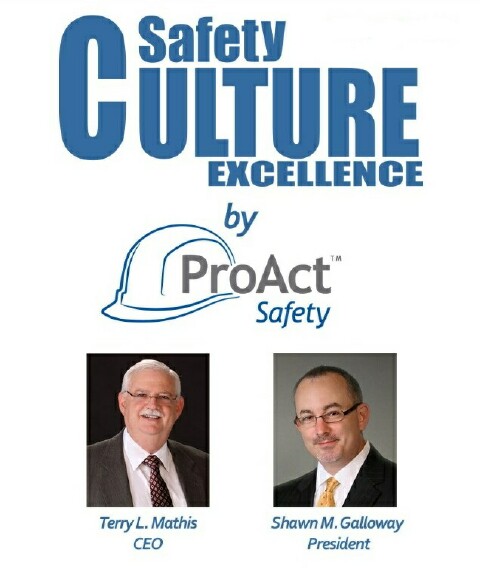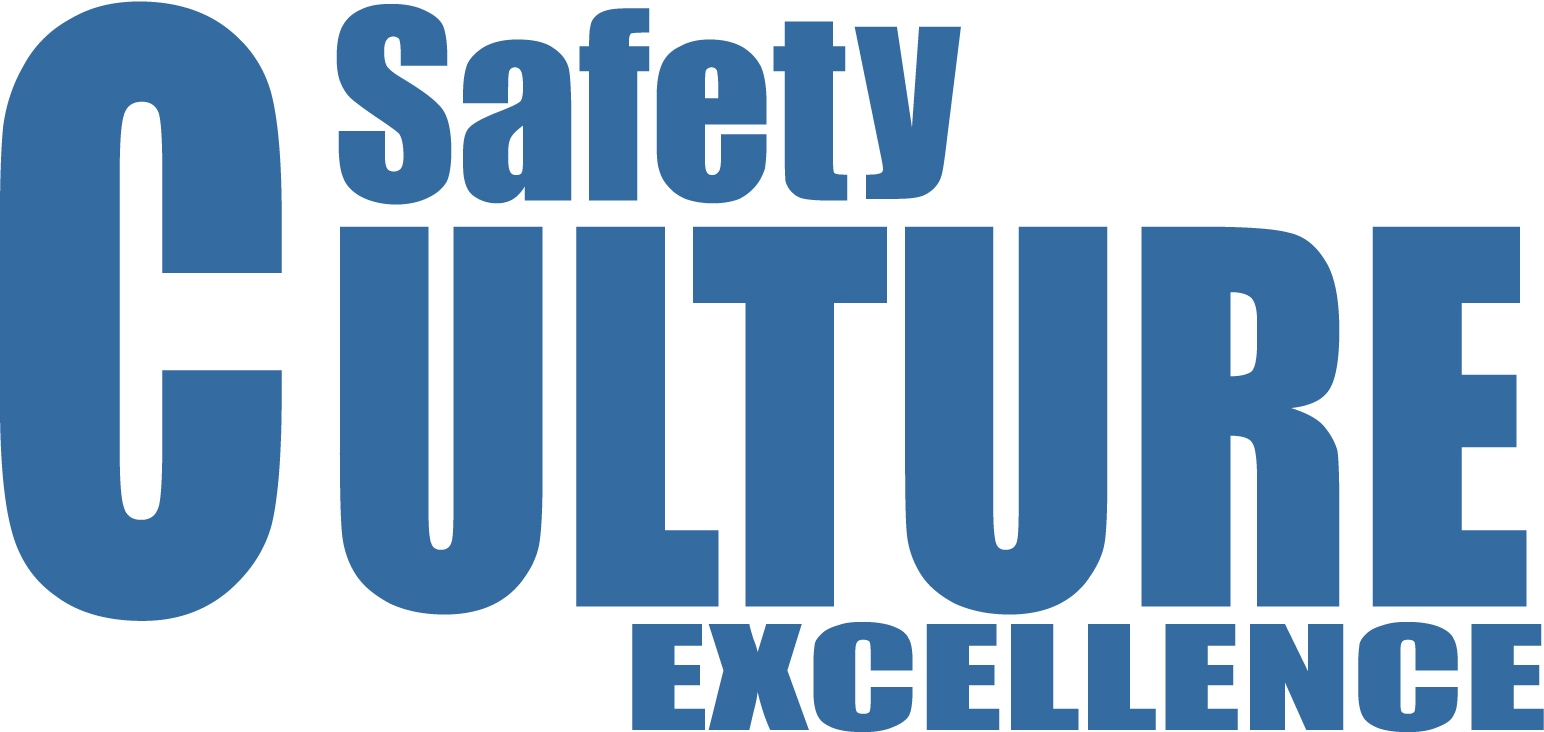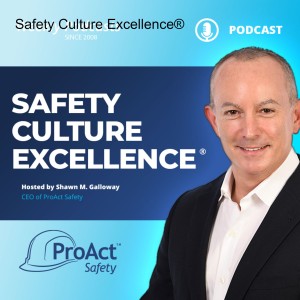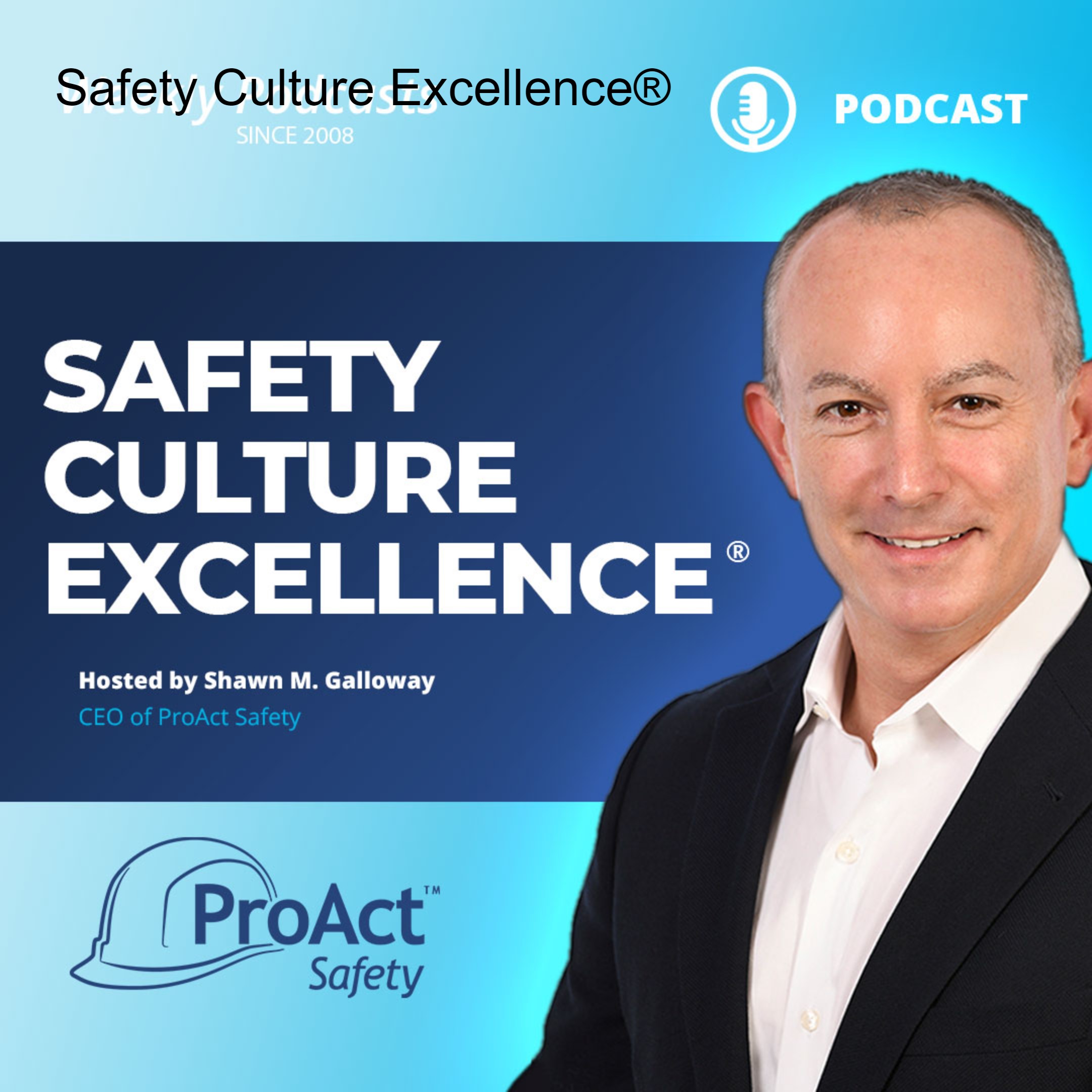Episodes

Monday Jun 02, 2014
339 - Conquer Distracted Driving by Becoming an ACE
Monday Jun 02, 2014
Monday Jun 02, 2014
Greetings everyone, this podcast recorded while in Lake Charles, LA. I’d like to share an article Terry Mathis wrote that was published April 2014 in EHS Today Magazine. The published article can either be found on the magazine’s website or under Insights at www.ProActSafety.com.
I hope you enjoy the podcast this week. If you would like to download or play on demand our other podcasts, please visit the ProAct Safety’s podcast website at: http://www.safetycultureexcellence.com. If you would like access to archived podcasts (older than 90 days – dating back to January 2008) please visit www.ProActSafety.com/Store. For more detailed strategies to achieve and sustain excellence in performance and culture, pick up a copy of our book, STEPS to Safety Culture Excellence - http://proactsafety.com/insights/steps-to-safety-culture-excellence
Have a great week!
Shawn M. Galloway
ProAct Safety

Wednesday May 14, 2014
Starting vs. Stopping
Wednesday May 14, 2014
Wednesday May 14, 2014
Is safety excellence a matter of stopping risks or starting precautions? Should we focus on the “thou shalt nots” of safety, or encourage positive action? This topic directly impacts the question we have discussed before, “Is safety excellence a matter of achieving success or avoiding failure?” But beyond that philosophical point, let’s discuss the tools used for starting and stopping human behavior and their side effects.
The ultimate behavioral stopping tool is punishment. In the behavioral sciences, anything that tends to stop behavior is consider punishment and what makes it effective is the timing and probability. Negative consequences for behavior that are certain and timely tend to stop, or “extinguish” the behavior. But punishment does not automatically start another behavior in its place. Artificially-imposed punishment can also damage relationships and culture. It can be important to stop certain behaviors that present unacceptable risks or damage safety culture, and punishment might be the right tool for that job.
Starting tools for behavior include positive reinforcement and motivation. If the safety challenge is getting workers to identify risks, take precautions or participate in safety activities, these starting tools can be invaluable. Starting tools also are relationship and culture builders. Workers who help each other start better practices and improve performance tend to strengthen the bonds between themselves.
Determining the right tools for safety excellence involves accurately identifying exactly what behaviors need to be stopped or started. An effective safety strategy should include these distinctions.
-Terry L. Mathis
Terry L. Mathis is the founder and CEO of ProAct Safety, an international safety and performance excellence firm. He is known for his dynamic presentations in the fields of behavioral and cultural safety, leadership, and operational performance, and is a regular speaker at ASSE, NSC, and numerous company and industry conferences. EHS Today listed Terry as a Safety Guru in ‘The 50 People Who Most Influenced EHS in 2010, 2011 and 2012-2013. He has been a frequent contributor to industry magazines for over 15 years and is the coauthor of STEPS to Safety Culture Excellence, 2013, WILEY.

Wednesday Apr 16, 2014
The Confrontation Calamity
Wednesday Apr 16, 2014
Wednesday Apr 16, 2014
The emphasis on the concept of confrontation in safety is epidemic. Consultants, books and articles taut the virtue of teaching workers to confront each other over safety issues. They claim that the willingness and ability to confront may be the key competency of safety. They argue that it must become unacceptable to see a risk being taken and not confront the individual taking the risk.
The basis of this misguided concept goes back to two core misconceptions of safety thinking, (i.e. the idea that the goal of safety is to fail less and that all risk-taking is a matter of worker choice). When one worker sees another being bad there must be a confrontation to make the worker less bad. The worker taking a risk simply made a bad choice and confrontation will result in less-bad decisions in the future. The truth is that safety excellence is about achieving success, not simply avoiding failure and that there are organizational influences that impact workers’ decisions that need to be discovered and addressed if lasting change is to be made.
The alternative to the concept of confrontation is the concept of coaching. Coaching is a way to achieve success rather than simply avoid failure. It involves workers building on each other’s strengths rather than simply trying to correct their weaknesses. It is built upon a vision of success in which everyone helps each other reach a goal. It necessitates a vision of success and helps to identify organizational influences on workers’ behavioral choices.
Confrontation weakens relationships and culture and seldom results in lasting change. Coaching builds relationships and culture and almost always results in improved performance. Workers listen to their allies differently than they listen to their critics. Confrontation creates either enmity within the safety culture or avoidance behavior that has the appearance of confrontation without the reality. Either damages the very fabric of what it is supposed to improve.
-Terry L. Mathis
Terry L. Mathis is the founder and CEO of ProAct Safety, an international safety and performance excellence firm. He is known for his dynamic presentations in the fields of behavioral and cultural safety, leadership, and operational performance, and is a regular speaker at ASSE, NSC, and numerous company and industry conferences. EHS Today listed Terry as a Safety Guru in ‘The 50 People Who Most Influenced EHS in 2010, 2011 and 2012-2013. He has been a frequent contributor to industry magazines for over 15 years and is the coauthor of STEPS to Safety Culture Excellence, 2013, WILEY.

Monday Mar 31, 2014
335 – Who Should Implement Behavior Based Safety?
Monday Mar 31, 2014
Monday Mar 31, 2014
Greetings everyone, this podcast recorded while in Anchorage, Alaska. I’d like to share an article I wrote that was published March 2014 in BIC Magazine. The published article can either be found on the magazine’s website or under Insights at www.ProActSafety.com.
I hope you enjoy the podcast this week. If you would like to download or play on demand our other podcasts, please visit the ProAct Safety’s podcast website at: http://www.safetycultureexcellence.com. If you would like access to archived podcasts (older than 90 days – dating back to January 2008) please visit www.ProActSafety.com/Store. For more detailed strategies to achieve and sustain excellence in performance and culture, pick up a copy of our book, STEPS to Safety Culture Excellence - http://proactsafety.com/insights/steps-to-safety-culture-excellence
Have a great week!
Shawn M. Galloway
ProAct Safety

Monday Feb 17, 2014
328 - Caring More Deeply About Safety
Monday Feb 17, 2014
Monday Feb 17, 2014
Greetings everyone, this podcast recorded while in Clinton, TN. I’d like to share an article Terry L. Mathis wrote that was published January 2014 in EHS Today Magazine. The published article can either be found on the magazine’s website or under Insights at www.ProActSafety.com.
I hope you enjoy the podcast this week. If you would like to download or play on demand our other podcasts, please visit the ProAct Safety’s podcast website at: http://www.safetycultureexcellence.com. If you would like access to archived podcasts (older than 90 days – dating back to January 2008) please visit www.ProActSafety.com/Store. For more detailed strategies to achieve and sustain excellence in performance and culture, pick up a copy of our book, STEPS to Safety Culture Excellence - http://proactsafety.com/insights/steps-to-safety-culture-excellence
Have a great week!
Shawn M. Galloway
ProAct Safety

Wednesday Nov 27, 2013
Leading vs. Lagging Indicators in Safety
Wednesday Nov 27, 2013
Wednesday Nov 27, 2013
As more and more leaders and safety professionals realize the limitations of reactive safety, they search for leading indicators to help them manage safety more proactively. This thinking fueled the concept that lagging indicators alone, are not truly representative of safety performance, nor are they predictive or prescriptive.
The first round of so-called “leading indicators” was little more than a measurement of safety-related activities: hours of safety training, attendance at safety meetings, participation in safety programs, etc. OSHA’s crackdown on incentives that could potentially suppress reporting of accidents drove many organizations to base their incentives on these activity metrics rather than simply not having an accident.
When behavior-based safety became the rage, the measurement of behaviors from observations came to be thought of as a leading indicator. As safety culture became a buzz phrase, perception surveys gained in popularity and came to be considered another potential leading indicator. The search for meaningful leading indicators goes on because no one of these has proven adequate in predicting and preventing injuries.
Where none of these alone succeed, all of them together potentially can. A balanced-scorecard approach in which the metrics not only complement, but predict each other has proven quite effective in proactively predicting how to prevent accidents. When you measure how much activity it takes to change perceptions, how much of a change in perceptions it takes to change behaviors, and how much behavior change it takes to change the lagging indicators, you begin to truly measure the effectiveness of safety efforts. Just as balanced scorecards have revolutionized strategic management, with our most successful clients, balanced scorecards for safety have proven to have a transformational impact on safety management. How balanced are your measurements?
-Terry L. Mathis
Terry L. Mathis is the founder and CEO of ProAct Safety, an international safety and performance excellence firm. He is known for his dynamic presentations in the fields of behavioral and cultural safety, leadership, and operational performance, and is a regular speaker at ASSE, NSC, and numerous company and industry conferences. EHS Today listed Terry as a Safety Guru in ‘The 50 People Who Most Influenced EHS in 2010, 2011 and 2012-2013. He has been a frequent contributor to industry magazines for over 15 years and is the coauthor of STEPS to Safety Culture Excellence, 2013, WILEY.

Monday Nov 11, 2013
315 - Measuring Behavior-Based Safety: The Perfect Leading Indicator
Monday Nov 11, 2013
Monday Nov 11, 2013
Greetings everyone, this podcast recorded while in Decatur, AL. I’d like to share an article I wrote, published September 2013 in OH&S Magazine. The published article can either be found on the magazine’s website or under Insights at www.ProActSafety.com.
I hope you enjoy the podcast this week. If you would like to download or play on demand our other podcasts, please visit the ProAct Safety’s podcast website at: http://www.safetycultureexcellence.com. If you would like access to archived podcasts (older than 90 days – dating back to January 2008) please visit www.ProActSafety.com/Store. For more detailed strategies to achieve and sustain excellence in performance and culture, pick up a copy of our book, STEPS to Safety Culture Excellence - http://proactsafety.com/insights/steps-to-safety-culture-excellence
Have a great week!
Shawn M. Galloway
ProAct Safety

Wednesday Oct 30, 2013
Little Things: The Biggest Things in Safety
Wednesday Oct 30, 2013
Wednesday Oct 30, 2013
It is logical to begin a safety effort by addressing the risks with the greatest probability for causing injuries and the highest severity potential. However, it is imperative that when the greater risks are addressed that the next ones in line get the new focus. If an organization ever develops the mindset that they have handled the big things and all that is left are little things, not worth the bother, this is a formula for disaster. Many rude wake-up calls have come via a rash of accidents caused by these “little things.”
Accidents are, after all, ambushes. If we saw them coming we would have avoided them. So it logically follows that anything we don’t keep our eyes on has the potential of ambushing us. Some experts suggest that workers get injured when they fail to recognize the risk. But underestimating the risk is equally dangerous.
Many have adopted a goal or vision of “zero injuries.” If properly explained and implemented, such a goal can keep organizations continuously addressing smaller risks as they successfully eliminate or manage larger ones. When accident rates go down, the effort does not stop; it simply refocuses itself on the next tier of risks. True excellence in safety is quite different from simply pretty good. No risk should ever be considered a “little thing.”
-Terry L. Mathis
Terry L. Mathis is the founder and CEO of ProAct Safety, an international safety and performance excellence firm. He is known for his dynamic presentations in the fields of behavioral and cultural safety, leadership, and operational performance, and is a regular speaker at ASSE, NSC, and numerous company and industry conferences. EHS Today listed Terry as a Safety Guru in ‘The 50 People Who Most Influenced EHS in 2010, 2011 and 2012-2013. He has been a frequent contributor to industry magazines for over 15 years and is the coauthor of STEPS to Safety Culture Excellence, 2013, WILEY.

Monday Oct 07, 2013
310 - Lean Behavior-Based Safety®: A Natural Evolution
Monday Oct 07, 2013
Monday Oct 07, 2013
Greetings everyone, this podcast recorded while in Las Vegas, NV. I’d like to share an article I wrote, published July 2013 in OH&S Magazine. The published article can either be found on the magazine’s website or under Insights at www.ProActSafety.com.
I hope you enjoy the podcast this week. If you would like to download or play on demand our other podcasts, please visit the ProAct Safety’s podcast website at: http://www.safetycultureexcellence.com. If you would like access to archived podcasts (older than 90 days – dating back to January 2008) please visit www.ProActSafety.com/Store. For more detailed strategies to achieve and sustain excellence in performance and culture, pick up a copy of our book, STEPS to Safety Culture Excellence - http://proactsafety.com/insights/steps-to-safety-culture-excellence
Have a great week!
Shawn M. Galloway
ProAct Safety

Wednesday Sep 04, 2013
Cultural Compliance: A Step Short of Excellence
Wednesday Sep 04, 2013
Wednesday Sep 04, 2013
What if everyone in your organization obeys the rules, follows the procedures and wears their PPE with a minimum of supervision or management? Is this safety culture excellence? NO! This is a culture of compliance, not excellence. Certainly, it is a move in the right direction and is a desirable accomplishment. It is a step above command-and-control but still a number of steps short of true excellence.
Excellence is well above and beyond simple compliance. Most rules and procedures are minimal standards for safety and only address the most common and obvious risks. Even organizations which reach high levels of compliance still have a level of accidents untouched by their efforts. As organizations begin to plateau in their compliance efforts, they often look for advanced strategies to help them accomplish the next step change.
Beyond compliance, workers must think and act intelligently; not just mindlessly comply. Organizations must examine their influences on workers to make sure they reinforce safety and not shortcuts or acceptance of risks. When all factors, both individual and organizational are aligned to go above and beyond compliance, the potential for excellence begins. At this level of performance, compliance is so basic that is expected of everyone all the time. The new measure of success is repeated victories, not simply playing a decent game.
-Terry L. Mathis
Terry L. Mathis is the founder and CEO of ProAct Safety, an international safety and performance excellence firm. He is known for his dynamic presentations in the fields of behavioral and cultural safety, leadership, and operational performance, and is a regular speaker at ASSE, NSC, and numerous company and industry conferences. EHS Today listed Terry as a Safety Guru in ‘The 50 People Who Most Influenced EHS in 2010, 2011 and 2012-2013. He has been a frequent contributor to industry magazines for over 15 years and is the coauthor of STEPS to Safety Culture Excellence, 2013, WILEY.

